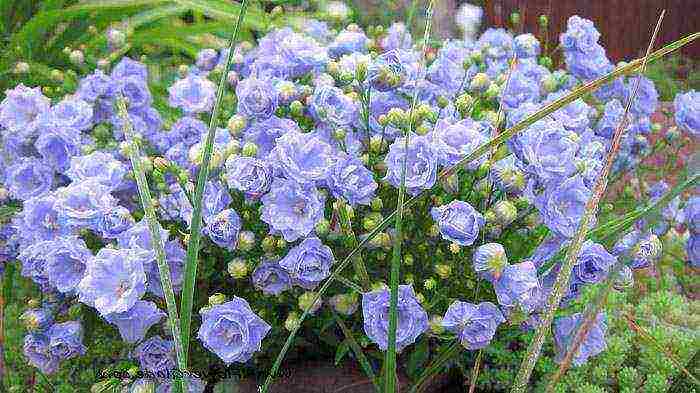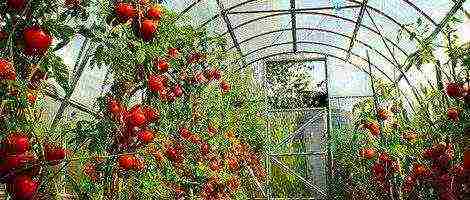Content [show]
Campanula as a houseplant has been undeservedly forgotten for a long time. Today she is back in fashion, but many flower lovers do not remember all the secrets of caring for her. Although Campanula is unpretentious, minor gardener mistakes can lead to the death of the flower. How to properly care for a beauty in order to fill the house with her bloom?
Terry campanula - origin and types
Campanula is a plant of the bellflower family. Popular names - "Bride and Groom", "Falling Stars". In honor of the future married couple, Campanula began to be called in connection with the color of the inflorescences: blue - the groom, white - the bride. And the second name reminds the amateur gardener that this plant is ampelous, i.e. you can't tie it up. It was customary to give Campanula for a wedding and put it in houses to fill them with vital energy.

Currently, more than 300 species of this plant are known. As a result of experiments, scientists have developed a variety of new varieties of inflorescences by selection method: small and large-leaved, terry, with wavy edges or in the form of a fringe. Of the hybrids, the most popular is terry campanula. Home care for it differs little from other types, but the decorative effect is much higher.
The plant can have inflorescences of various shades: blue, light blue, lilac, white, pink and others. The most famous varieties that gave the name to Campanule "Bride and Groom" are "Alba" (white) and "Maya" (blue).
Campanula is a herb that has been growing for several years. Its shoots reach a length of 25 cm, hang down gently or spread along the ground. The leaves are rounded, heart-shaped, light green in color. In diameter, inflorescences can reach 3-4 cm.
Terry campanula - landing
Since campanula grows in nature on rocky soil, it will need a loose, rarefied soil. As a last resort, a versatile blend from a flower shop will do. However, a more suitable combination would be:
turf;
leaves;
peat;
sand.
They need to be taken in proportions of 6: 3: 1: 1. It is recommended to plant immediately in a large pot, since this plant has a powerful root system and quickly develops the soil.
You can plant 2 varieties in one pot: with white and blue inflorescences. But then you need to make a partition in the ground, otherwise the white variety will "survive" the blue one.
There are 2 ways to propagate a plant:
- Seeds. They are planted in early spring in a small bowl and lightly sprinkled with earth. Watering is recommended from a spray bottle.
- Cuttings. This is a faster and more reliable way. The best time for breeding is the beginning of spring, when the outside air temperature reaches 10 degrees.Cuttings taken from the bottom of the mother plant are dipped in a weak solution of potassium permanganate and left for 7-8 hours. Then the shoot should be transferred to clean water and wait until it starts to take root. The stalk is placed in a ring in the soil and sprinkled with earth, having previously removed the top and inflorescences. Abundant watering is not required. It is advisable to cover the stalk with a plastic bag or jar, creating a homemade greenhouse. When the plant is accepted, you can gradually accustom it to room temperature by removing the greenhouse for 10 minutes in the morning and evening and gradually increasing the time.
Read also:
Common heather - benefits and harms
Terry campanula care
Although the campanula is unpretentious, landing and leaving are fraught with many pitfalls. To get lush blooms, follow some simple care tips.
- A place. Terry campanula, like other varieties, perfectly take root on balconies, verandas in the warm season. Indoors, the plant is best placed in places facing the west and east, for example, in the opening between windows or in a hanging pot.
- Lighting. Campanula does not like direct rays of the sun: the light should be diffused. However, even in dark places, this flower does not survive; the stems lose their decorative effect, becoming long, the gaps between the leaves increase. The campanula has one feature - to stretch towards the light source. It cannot be rotated 180 degrees. If there is not enough light in the room, make the turns gradually.
- Temperature. The flower prefers coolness, so a living room or bedroom (but not the kitchen!) Will be a great place for it. It is better to place the plant away from the window: the campanula does not like direct drafts. In the warm season, the optimal temperature will be 22-23 degrees, in winter - 12-15 degrees.
- Watering and humidity. During the growing period and in dry conditions, the plant should be watered daily with warm water. In winter, spraying is sufficient.
- Fertilizers. During the landing period, it is better not to experiment with them. Further, when the plants take root, any mineral fertilizer or organic matter will do.
- Hygiene. In autumn and spring, campanula needs to be pruned - to remove dried, too thin or fattening stems. This event will provide excellent breeding and transplanting material. It is recommended to renew the soil once a year, since the strong roots of the campanula quickly deplete the soil. You cannot do without updating the flower itself. To do this, it is enough to regularly plant cuttings and remove old ones. Campanula leaves must be sprayed or wiped from dust. Clean foliage is the key to lush flowering.
- Wintering. Campanula growth slows down in autumn. At this time, too long stems are pruned, dried inflorescences are removed and the plant is removed to a cool place. Before this, it is recommended to lubricate the cut points with a disinfectant or crushed coal.
- Watering in winter is very rare, but do not forget about daily spraying. Heating in houses and apartments creates a dry microclimate, and the soil near the campanula must always remain moist. When spring comes, the plant needs to be pruned again and moved to a warm place.
- Diseases. Campanula can be susceptible to spider mites or scabies. In this case, the plant is treated with insect repellents. Another enemy of the beauty is gray rot, which occurs due to excess moisture and excessive watering.
Read also:
Campanula care
All kinds of bells
Hosta - an ornamental plant
Compared to some exotic species of indoor plants, campanula is unpretentious. Planting and care, including the usual procedures for any grower, does not require an excessive investment of time and effort. At the same time, the appearance of this flower is able to compete with many brethren and is truly pleasing to the eye.
Discuss this article on the forum
- How to grow crocuses, crocus care
- Clematis in Siberia: growing, planting and care
- How to grow steak
- Platicodon: growing from seeds, planting in open ground
- Growing and caring for agrostemma
Campanula is an adorable plant that was very popular with our grandmothers. The people called her "the flower of family happiness", as well as "the bride and groom." In the old days, campanula was given to newlyweds so that prosperity and peace reigned in their house. In recent decades, many growers have become enthusiastic about planting exotic varieties, forgetting about this indoor bell, but now the fashion for the plant is returning. Campanula can become a real home decoration. The main thing is to take a responsible approach to caring for a flower at home.
The origin and appearance of the campanula
There is a charming plant in the Bellflower family called Campanula, which is grown with pleasure by flower growers in indoor conditions.
The homeland of Campanula is considered to be the Mediterranean, but it is found naturally not only in southern Europe, but also in Asia, the Caucasus and even in some regions of North America.
In translation, campanula means "bell". The plant got its name due to the characteristic shape of the flower.
The plant is a small perennial herbaceous shrub, reaching a height of 30-50 cm. Campanula has long shoots of a light green shade and flowers, painted in white, blue or purple.
The snow-white campanula was popularly dubbed "the bride", and the plant with blue and purple flowers - the "groom". There is another popular name - "flower of family happiness". In ancient times, there was also a belief that this plant gives happy love to girls, and serene old age to the elderly.
The flowering of campanula continues for a long time. It begins in late spring and lasts until mid-autumn, with a dormant period in winter.
Campanula is considered a capricious plant that requires special care when grown in captivity. He needs timely watering, even with the slightest lack of moisture, tender shoots can die. But if you find the brightest and warmest place for the bell, and also provide it with the necessary care, then it is quite possible to get a lush and long flowering in an ordinary apartment.
Types and varieties that are popular in indoor floriculture
Biologists have described about 300 species of campanula, but only a few of them are grown "in captivity".
- Campanula is equal-leaved. This species is most commonly grown as a houseplant. The flower reaches a height of no more than 30 cm and has an ampelous shape. Its thin stems hang under the weight of the flowers, so it is recommended to keep it in hanging pots. In the spring and summer period, the bell is covered with numerous flowers. The most popular varieties are Mayia ("groom" with blue flowers) and Alba ("bride with white flowers"). The variety Napoli with large blue bells is very beautiful, the hybridizers created a bride for the groom - the Atlanta variety with similar white flowers.
- Campanula Pozharsky. Under natural conditions, the flower grows on limestone rocks in the Balkan Peninsula. A very spectacular plant forms a dense clump of heart-shaped leaf blades, the average height of which is 15–20 cm. Abundant flowering. The bells are star-shaped, painted in a light blue or plum shade. Hybridizers have bred a cultivar with snow-white flowers.
- Campanula Blauranca. The plant is one of the varieties of the Pozharsky campanula. A distinctive feature is large leaf blades and flowers in combination with a compact bush shape.
During its flowering, Blauranca attracts attention with flowers painted in a delicate light blue hue. This campanula is suitable for growing both in the apartment and in the garden.
- Campanula Carpathian (Carpathica). The bellflower of this species is a perennial plant. The shape of the leaf blades located in the root part of the flower is rounded. The color can be different, ranging from snow-white to purple.
- Campanula Portenschlag. A perennial flower with heart-shaped green leaves and dark purple-colored bell-shaped flowers. Campanula Portenschlag blooms for a long time (from May to September). The advantage is that the bell does not lose its decorative effect even after the end of the flowering period. Even at sub-zero temperatures, the leaf blades remain green. Old leaves dry up only when young shoots appear in spring.
- Campanula mini terry. Double-flowered hybrids are most commonly found in specialized flower shops. Such a bell is a small bush, up to 15 cm high, covered with double flowers of various shades of blue and white. The varietal variety includes Blue Bali and White Bali, as well as Blue Wonder and White Wonder.
Photo gallery: mini Terry Campanula, Pozharsky, Portenschlag, Carpathian (Carpathica), Napoli blue and other varieties
Conditions required for a bell depending on the season - table
The nuances of planting and transplanting
Soil preparation
The soil for the campanula should be loose and light. Adequate aeration (ventilation) is required for the roots of a house bell. The ideal growing medium is a mixture of peat and leafy soil (in equal proportions). But a ready-made universal primer is also suitable.
Choosing a bell container
The pot for the campanula should not be too wide and deep.
Important! For a flower to bloom well, a fairly tight pot is needed. The roots should completely entwine the earthen ball.
At each subsequent transplant, it is worth choosing a container 1–2 cm larger than the previous one.
Transplant - a step-by-step description of the process
The annual traditional transplantation required by many indoor flowers is not required for campanula. This event is only needed after buying a plant in the store, as well as in the case when the old pot has become too cramped and the roots look out of the drainage holes.
Every two years, Campanulu needs to rejuvenate and plant the plant by dividing the bush.
- Place a layer of expanded clay drainage in the container. It should be large enough and take up 1/4 of the pot.
- Pour in the nutrient medium, filling half the pot with it.
- Remove the campanula from the old flowerpot, shake the soil from the roots and rinse them in warm water. Cut the damaged roots.
- Place the flower in a pot, straighten the roots and cover the voids with earth. Water the campanula and put it on for 2-3 days in partial shade.
- Once the bell is rooted, move it to its original location. A bell transplant is required if the roots are completely entwined with an earthen ball and it is cramped in the pot
After buying a campanula in a store, the plant must be transplanted with a complete replacement of the soil. The procedure should be carried out no later than 2-3 days after you brought the flower home, since the plant can die very quickly and it will be almost impossible to revive it. Before transplanting, remove all flowers and buds and shorten the shoots.
It is necessary to replant the bell in the spring (before flowering).
Campanula care at home
Features of watering and feeding
In the summer, campanule requires regular watering. The substrate in the flowerpot should not be allowed to dry out, so you need to moisten the flower daily. In this case, it is best to carry out the procedure in the morning or evening hours, since watering on hot soil can lead to burns of delicate roots.
In winter, during a period of relative dormancy, the humidification of the bell should be reduced to once a week, since the roots of the campanula can rot with excessive dampness and coolness.In addition, the shoots will grow thin and too fragile.
The bell blooms almost without interruption for several months in a row, which greatly depletes the plant. To maintain its strength, it is necessary to regularly apply fertilizers to the soil. Top dressing from early spring to late summer should be done every two weeks. Preparations for violets, for example, Kemira-lux or Fertika, are suitable. They need to be diluted according to the instructions and the campanula should be poured with a nutrient solution over damp ground.
Note! In autumn and winter, feeding should be completely stopped. They can only be renewed in spring.
How to make campanula bloom
The bell begins to bloom in late May and early June. The period lasts for several months. In summer, the flowers completely cover the shoots, and in late August and early September, flowering gradually fades away. To stimulate the formation of new buds, you need to systematically pinch off old flowers.
Sometimes it happens that the campanula does not want to bloom. To prevent this from happening, it is necessary to arrange a relative rest period for the plant in winter. Place it on a cool window, but brightly lit. Stop feeding and reduce watering. After such stress, the flower will bloom very luxuriantly.
It is interesting! Pinching is another way to stimulate flowering. In the spring, as soon as the shoots start to grow, pinch off their tops, and then pinch the tops of the lateral shoots that have appeared.
Pruning and shaping the bush
The bride and groom are ampelous plants. When planting, you need to cut off the shoots, leaving 2-3 cm from the root.
Campanula is best planted in a hanging planter or flowerpot with a high leg so that the stems hang down beautifully. Remove dry twigs and faded buds throughout the period to give the flower a neat look.
A very beautiful composition is obtained by planting plants with blue flowers (groom) and white bells (bride) in one pot. Experienced flower growers say that over time, the bride begins to grow more actively and oppresses the groom. To prevent this from happening, when planting plants in one flowerpot, install a partition in the middle of the planter and put the bride and groom in different parts of the pot.
The consequences of improper care and how to solve problems - table
Diseases and pests
Subject to the habitat conditions of the bell, the flower grows healthy. But if the irrigation regime is violated, in particular with excessive dryness, the campanula is often exposed to fungal diseases, especially root rot. With a lack of moisture, the plant is not immune to the appearance of spider mites and scabies.
With excessively dry air, a shield appears on the campanula
How to deal with diseases and pests of campanula - table
Reproduction of campanula - step-by-step master class
Campanula reproduces in several ways: by dividing the bush, cuttings and seeds.
From seed
- Spread the Campanula seeds over the damp soil.
- Press lightly and moisten with a spray bottle.
- Cover the seed bowl with a clear bag or plastic lid. Place in a sunny place.
- Moisten the planting daily, ventilate the greenhouse, and wipe off any condensation that collects on the lid.
- Seeds hatch very quickly. As soon as the first leaves appear, open the greenhouse and cut the seedlings into separate cups. Campanula seedlings are very fragile
Cuttings
Bell propagation by cuttings should be carried out in the fall.
- Cut off a shoot with several leaves. Choose cuttings at the bottom of the flower.
- Place the cuttings in a container with a weak solution of potassium permanganate for 30 minutes.
- Place them in clean, soft water and wait for the roots to appear.
- Prepare the soil for planting rooted campanula cuttings by composing it with peat and sand (in equal parts).
- Plant the rooted cuttings to a depth of 3 cm.
- Cover the bowl with plastic wrap.
- Moisten the planting and spray with water at room temperature, preventing the soil from drying out.
- After 3-4 weeks, plant the young plants in separate pots. Campanula cuttings take root quickly enough
By dividing the bush
In the spring, when transplanting campanula, it is advisable to rejuvenate the bush by division. Thus, you can not only update the plant, but also multiply it.
Reproduction of campanula is advisable to carry out when transplanting a plant.
Divide the rhizome of the flower with a knife into several parts. Drop each one in a separate container. Then water the plants and place them in a shaded place for a few days.
Campanula: home care tips - video
Florist reviews about Campanula
Campanula is a charming plant that will become a real decoration of your home, bring peace and harmony to it. These cute bells bloom non-stop all summer long.


